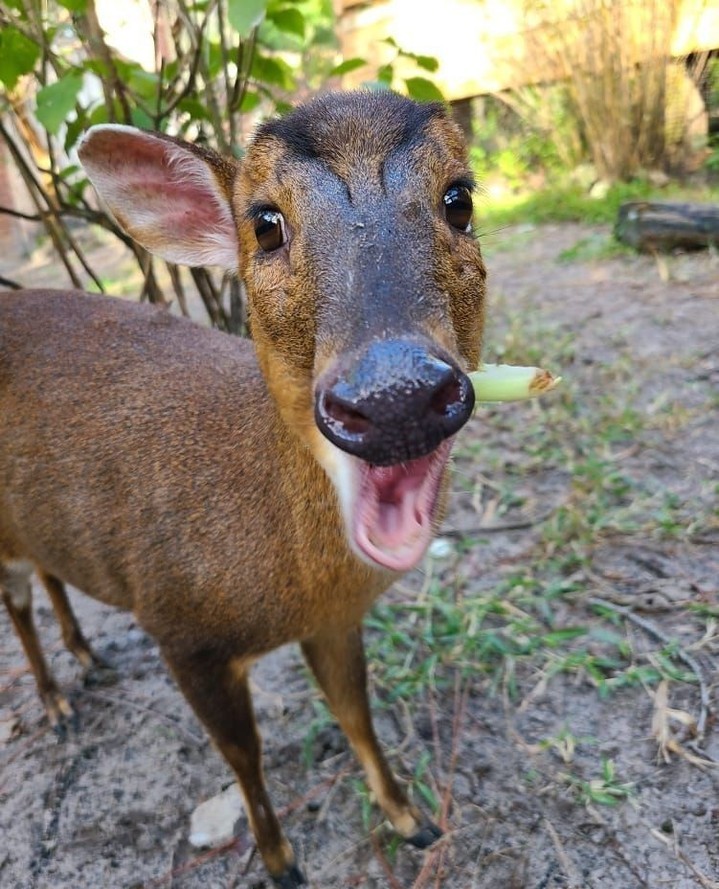– Unveiling the unique vocalizations of the muntjac, a deer-like animal with a canine twist.
– Exploring the secretive life and behaviors of muntjac deer in their natural habitat.
– Understanding the adaptive reasons behind the muntjac’s unusual barking sound.
In the sprawling tapestry of nature’s symphony, the whispers of leaves, the rustling of undergrowth, and the musical calls of countless creatures blend into a chorus of the wild. Amongst this natural orchestra, imagine entwining threads of a canine bark within a forest decidedly lacking the presence of dogs. Here, we turn our gaze to the muntjac, a creature garbed in the cloak of a deer yet possessing a vocal range that dips into the timbre of our four-legged canine companions.
The muntjac, a diminutive deer with roots tracing back to Asia, offers a peculiar spectacle to the unsuspecting observer. Their modest size might draw comparisons to certain familiar and fuzzy herbivores. At the same time, their vocal abilities might suggest a connection to barking bunnies if such creatures existed outside the realm of imagination. However, the muntjac is neither a bunny nor a dog but an intriguing species occupying its own niche.
On a lucky walk through dense forests or scrubland, where muntjacs often roam, one might be privy to the singular experience of their bark. Such a sound can startle, seeming incongruous against the backdrop of forest fauna. The barking serves numerous functions: a warning to competitors, an alarm signal, or even a mating call. The muntjac’s bark resonates as a stark reminder of nature’s ability to surprise and of the evolutionary ingenuity that shapes the communication of animals.
Most active at dawn and dusk, these crepuscular characters embody mystery. Their elusive nature often renders them mere shadows flitting through trees—but why? Why do such clandestine habits exist, and what secrets do their silence guard?
The answers lie in an understanding of their life history and behavioral patterns. Muntjacs are solitary. For mothers with fawns or brief partnerships during mating season, they often walk alone, threading through the forest with an enviable calm. This preference for seclusion underlies the creature’s need for a robust alarm system—thus their distinctive bark, a sounding bell against predators.
Adaptability radiates through every facet of the muntjac’s being. They are survivors who can thrive in diverse environments, from dense forests to suburban fringes. Such versatility has not gone unnoticed by human populations, and as such, muntjacs have found their way from native lands to far-off places like the United Kingdom, where they now roam with a prospering presence.
The raison d’être of their adaptability may stem partly from their diet. They are true generalists, munching on various herbs, flowers, fruits, and the occasional tree bark. This eclectic palate allows muntjacs to wander with gastronomic impunity, carving their niches in contested territories and ensuring survival where more specialized feeders may falter.
Yet, such survival prowess does not come without its costs. Their omnivorous diet and burgeoning populations lead to clashes with human interests, often painting muntjacs as nuisances. Room for coexistence becomes an ever-pressing question mark as human expansion encroaches further upon wildlife territories.
Much like other creatures of the forest, Muntjacs also have their legends, rendering them characters in human culture. They slide through the myths and folklore of various cultures, signifying good fortune, grace, or sometimes an omen of something more sinister—a testament to their impact on the human psyche and their perceived mystical quality.
Though their presence extends beyond the realm of tales and into the very real fabric of ecosystem dynamics, muntjacs play a role in seed dispersal, their movements nurturing the forest as they carry potential life across distances. But this same movement can become problematic when non-native flora is introduced, aiding the spread of invasive plants—a balance tipped easily in an intricate ecological web.
Furthermore, though the catchphrase ‘barking bunny’ adds a touch of whimsy to the muntjac’s image, it obfuscates their deeper narrative—one of conservation concerns. As some species face dwindling numbers due to habitat loss and hunting, their continued existence tugs on the strings of concerted conservation efforts.
What essence, then, can we distill from these barking denizens of the underbrush? They remind us of the intricate dance of adaption and survival, the silent march of evolution that carries the haunting calls of the past merging with the present notes. Should we chance upon the bark of a muntjac while wandering forest paths, let it serve as a summons—a call to wonder and a nudge to remember the ever-unfolding story of nature, where nothing is quite as it seems and where the line between the wild and the whimsical is forever blurred by the brushstrokes of life’s grand design.
Ultimately, the tale of the muntjac is a tapestry rich with threads of adaptability, ecology, and the eternal interplay between creatures and their habitats. As humanity edges ever closer into the realms where these beings tread, it’s crucial to approach with curiosity and caution. By gaining a deeper appreciation of the unique lives of such animals, perhaps we can navigate the future with greater empathy and shared space for all beings that call this planet home.
Now, let the notion of ‘barking bunnies’ serve as a metaphorical prism through which we might view the natural world—a place of untold stories, whispered secrets, and cries that can sometimes sound all too familiar yet come from the most unexpected sources. It’s a reminder that nature holds fables and mysteries waiting to be deciphered, and only through a keen and patient ear to the ground can we hope to unravel them.
*****
Source Description
Are they barking bunnies in disguise? Muntjacs might look like deer, but listen closely – their excited calls sound like a dog’s bark! 🤨

